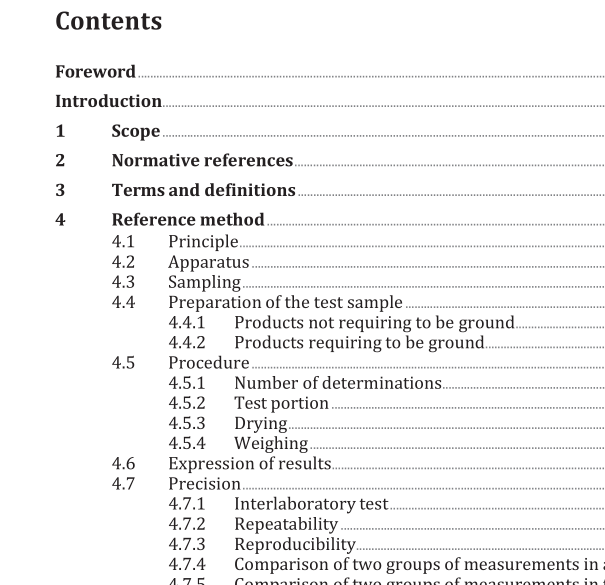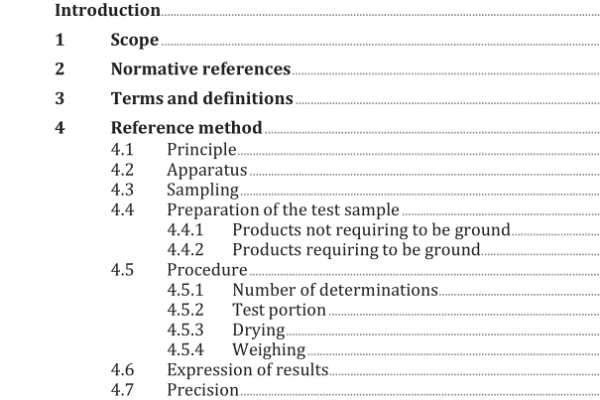ISO 6540:2021 pdf download – Maize — Determination of moisture content (on milled grains and on whole grains).
4.4.2 Products requiring to be ground 4.4.2.1 General If the laboratory sample does not have the particle size characteristics mentioned in 4.4.1, it shall be ground either without pre-conditioning ( 4.4.2.2 ) or with pre-conditioning ( 4.4.2.3 ) as required. 4.4.2.2 Grinding without pre-conditioning For products that are not likely to undergo variations in moisture content in the course of grinding (in general, products with a moisture content between a mass fraction of 9,00 % and 15,00 %, see 4.8), carry out grinding without pre-conditioning. Adjust the grinding mill ( 4.2.3 ) to obtain particles of the dimensions indicated in 4.4.1. Then quickly grind about 30 g of the laboratory sample, mix with a spatula and proceed immediately as specified in 4.5.1. 4.4.2.3 Grinding with pre-conditioning Products that are likely to undergo changes in moisture content in the course of grinding (in general, products with a moisture content more than a mass fraction of 15,00 % or less than a mass fraction of 9,00 %) shall be pre-conditioned to bring their moisture content to between a mass fraction of 9,00 % and 15,00 %, see 4.8) before grinding. If the moisture content is greater than a mass fraction of 15,00 % (which is the more frequent case), weigh, to the nearest 0,1g, about 100 g of the laboratory sample in the metal boat (4.2.4), place this in the oven ( 4.2.7 ) controlled at between 60 °C and 80 °C, and leave it for the time necessary to bring the moisture content to between a mass fraction of 9,00 % and 15,00 % . Take the boat out of the oven and allow it to stand in the laboratory atmosphere for the time necessary (at least 2 h) for the pre- conditioned sample to return to the laboratory temperature and for the moisture distribution to be relatively uniform. During this rest, it shall be ensured that no addition or withdrawal of material is made to the contents of the boat. If necessary, cover it with a sheet of paper but not with a lid, since this could limit the exchange of moisture between the air and the grain. After conditioning, weigh the sample to the nearest 0,1 g, then, proceeding rapidly, grind about 30 g of this product. Mix using a spatula. If the moisture content is less than a mass fraction of 9,00 %, place about 100 g of the laboratory sample, weighed to the nearest 0,1 g, in a suitable atmosphere (usually that of the laboratory) and leave it until a moisture content within the limits specified above is obtained. 4.5 Procedure 4.5.1 Number of determinations For each laboratory sample, carry out the determination in duplicate. Carry out one determination on each of the two ground test portions taken from the laboratory sample, in accordance with 4.5.2 to 4.5.4. If the absolute difference between the two results is greater than the repeatability limit given in 4.7.2, repeat the determination until the requirements are met. 4.5.2 Test portion For each sample, tare to the nearest 0,001 g two metal capsules ( 4.2.5 ) beforehand. For each capsule, note the tare t . Weigh rapidly, to the nearest 0,001 g, approximately (8 ± 1) g of the test sample (see 4.4.1, 4.4.2.2 or 4.4.2.3 , as appropriate) into the capsule. Note the mass m′ 0 .
ISO 6540:2021 pdf download – Maize — Determination of moisture content (on milled grains and on whole grains)






